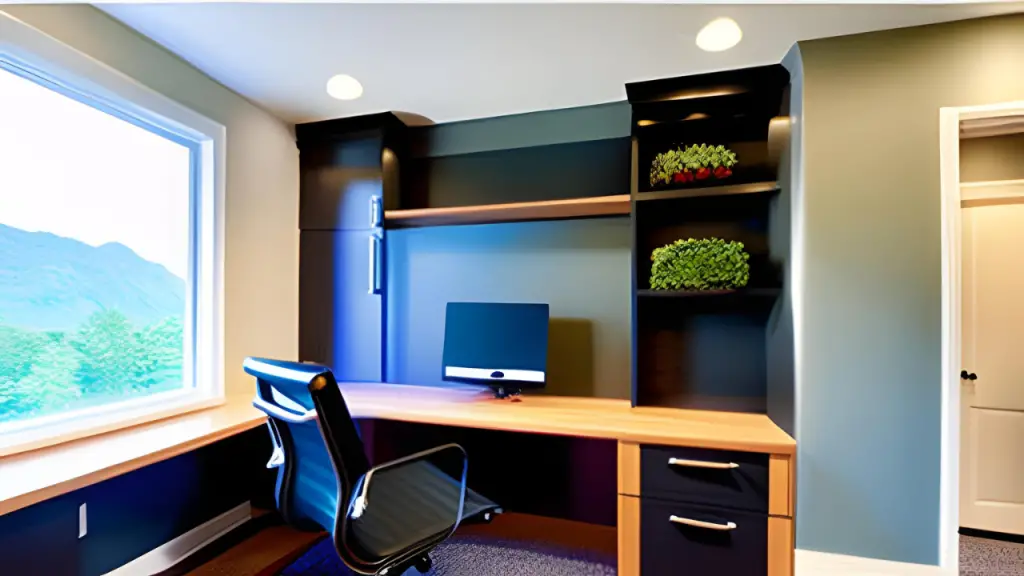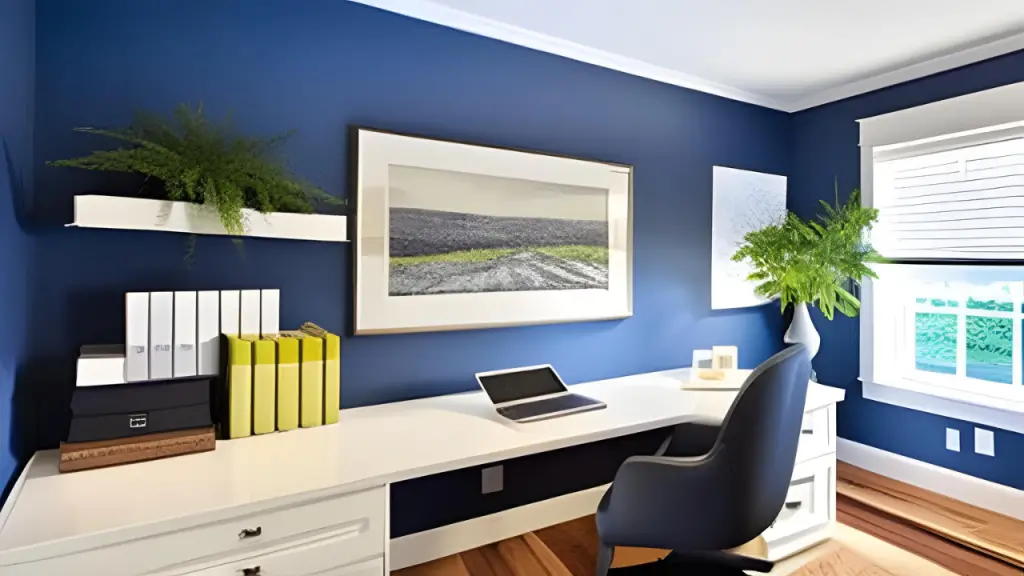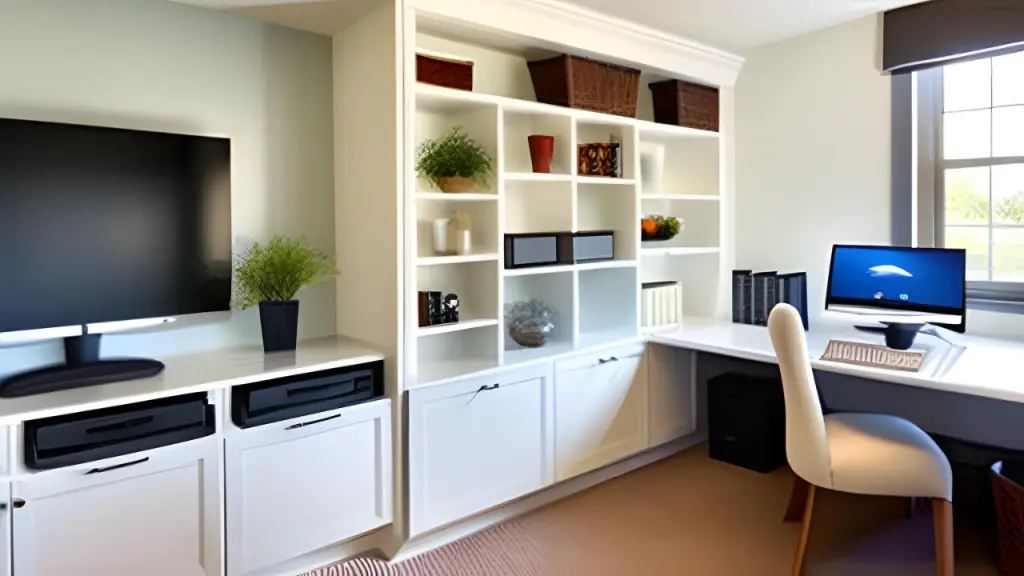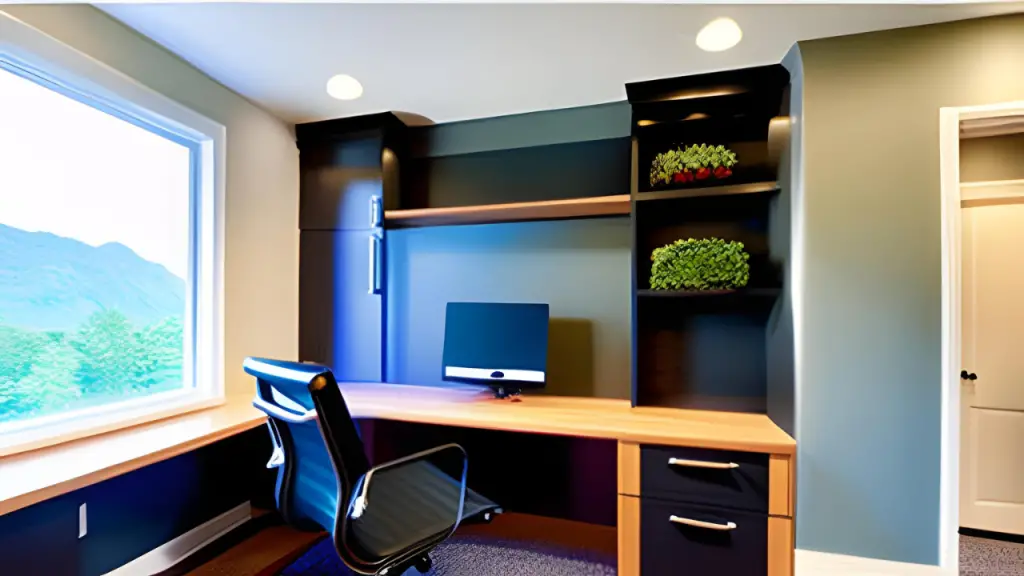
Are you looking for vertical space optimization tips for home office? Do you know that working from home has become increasingly popular recently? This is why having a well-set up home office is efficient and well-organized home office is essential for productivity and comfort. One crucial aspect of creating an ideal workspace is vertical space optimization.
“To maximize home office space, utilize wall-mounted shelves, hang a pegboard, invest in vertical filing cabinets, use floating shelves for décor, opt for wall-mounted desks, install overhead cabinets, use vertical file organizers, and add wall-mounted magazine racks.”
By effectively utilizing these office setup tips for vertical space in your home office, you can maximize storage, enhance functionality, and create a visually appealing environment. In this article, I will provide 25 vertical space optimization tips for your home office, ensuring you maximize every inch available.
Vertical Space Optimization Tips for Home Office
Creating an organized and functional home office requires careful consideration of various elements. Following these 25 vertical space optimization tips, you can transform your workspace into an efficient and inspiring environment.

1. Utilize Wall-Mounted Shelves
Wall-mounted shelves are a fantastic way to maximize vertical space while providing ample storage for books, files, and office supplies. You should install sturdy shelves that can hold the weight of your essentials and arrange them visually pleasingly.
2. Hang a Pegboard for Versatile Storage
A pegboard offers excellent flexibility for organizing your home office. Install one on a wall, and use hooks, pegs, and baskets to hang and store frequently used items such as scissors, tape, and markers. This allows easy access and keeps your desk clutter-free.
3. Invest in Vertical Filing Cabinets
Instead of traditional horizontal filing cabinets, opt for vertical ones with less floor space. These cabinets provide ample room for organizing documents and can be easily tucked away in a corner or against a wall.
4. Use Floating Shelves for Decorative Storage
Floating shelves provide storage and add a touch of elegance to your home office. Display decorative items, potted plants, or books on these shelves to create a visually appealing environment.
5. Opt for Wall-Mounted Desks
If you have limited floor space, consider installing a wall-mounted desk. These space-saving desks can be folded up when unused, allowing you to reclaim the area for other activities.
6. Install Overhead Storage Cabinets
Use the overhead space in your home office by installing storage cabinets. These cabinets can store items that are not frequently accessed, keeping your workspace tidy and organized.
7. Use Vertical File Organizers
Vertical file organizers are ideal for keeping important documents within reach. Place them on your desk or mount them on the wall to easily access files and folders.
8. Hang a Corkboard for Notes and Inspiration
A corkboard is a versatile addition to any home office. Hang one on the wall and pin important notes, reminders, and inspirational quotes. This helps keep your workspace organized and serves as a visual motivation.
9. Install Wall-Mounted Magazine Racks
Consider installing wall-mounted magazine racks if you enjoy reading or frequently reference them for work. These racks keep your magazines neatly organized and prevent them from occupying valuable desk space.

10. Use Vertical Desk Organizers
Vertical desk organizers are a practical solution for storing pens, pencils, and other small office supplies. These compact organizers maximize desk space while keeping everything easily accessible.
11. Hang a Whiteboard for Quick Notes and Planning
A whiteboard is an excellent tool for jotting down quick notes, brainstorming ideas, and planning your work schedule. Hang one on the wall, ensuring it is within reach and visible from your workspace.
12. Invest in Desk Risers
Desk risers are an effective way to elevate your computer monitor or laptop, creating additional space underneath. This allows you to store essential items such as keyboards or notebooks and maintain an ergonomic setup.
13. Utilize Door and Wall-Mounted Hooks
Hooks are versatile storage solutions that can be mounted on doors or walls. Hang items such as bags, headphones, or coats to keep them off the floor and free up space in your home office.
14. Opt for Nesting Tables
Nesting tables are practical and stylish additions to your home office. These tables can be stacked or used separately, providing extra surface area when needed and minimizing clutter when not in use.
15. Utilize Wall Pockets for Paperwork
Wall pockets are an efficient way to organize paperwork and clear your desk. Install them on the wall within reach, and sort your documents accordingly for easy access.
16. Use Cable Management Solutions
Cable management is essential for a tidy and hazard-free home office. Invest in cable clips, sleeves, or trays to keep your cords organized and prevent them from tangling.
17. Opt for Wall-Mounted Lighting
To save space on your desk, consider installing wall-mounted lighting fixtures. These provide ample illumination while keeping your workspace clutter-free.
18. Invest in a Wall-Mounted Bookshelf
If you have an extensive book collection, a wall-mounted bookshelf is a fantastic space-saving solution. Arrange your books in an organized and visually pleasing manner while freeing up valuable desk space.
19. Utilize the Space Underneath Your Desk
Make use of the often-neglected space underneath your desk. Install storage bins, shelves, or hanging organizers to store extra paper, stationery, or office equipment.
20. Hang a Magnetic Board for Quick Reference
A magnetic board is a practical addition to your home office. Hang one on the wall and use magnets to attach important documents, reference materials, or calendars for easy access.
21. Utilize Rolling Carts for Storage
Rolling carts are versatile storage solutions that can be moved around as needed. Use them to store office supplies, files, or frequently used equipment.
22. Invest in Adjustable Shelving Systems
Adjustable shelving systems offer flexibility in organizing your home office. These systems allow you to customize shelf heights according to your storage needs, ensuring efficient space utilization.
23. Use Desk Drawer Organizers
Maximize the vertical space within your desk drawers by using organizers. These dividers and trays help keep your supplies and small items neatly arranged and easily accessible.

24. Hang a Wall-Mounted Calendar or Planner
Stay organized and keep track of important dates by hanging a wall-mounted calendar or planner. Choose a size that suits your needs and ensure it is visible from your workspace.
25. Incorporate Foldable Furniture
A foldable furniture is an excellent option for small home offices. Consider a folding table or chair that can be easily stored away when not in use, providing you with more floor space.
What to Consider Before Vertical Space Optimization for Home Office
Vertical space optimization can be an excellent strategy to make the most of a small or cramped home office. You can create more room for storage, work surfaces, and decoration by utilizing wall space and other vertical areas. Here are some factors to consider before embarking on this organizational approach:
Assessment of Needs and Goals
Identify what you need from your home office space and what you intend to achieve with vertical optimization. Consider the tools, materials, or equipment you use regularly and how vertical space can improve accessibility.
Space Analysis
Measure the available vertical space, including wall and shelf dimensions. Consider windows, doors, heating vents, and other obstructions that limit vertical usage.
Budget Considerations
Determine what you can afford to spend on shelving, cabinets, wall mounts, etc. Look into DIY solutions if budget constraints are a concern.
Aesthetic Considerations
Think about how the vertical optimization will blend with your existing décor and personal style. Consider color schemes, materials, and designs that can enhance your workspace.
Structural Integrity
Check the walls’ condition and structural integrity if you plan to install heavy shelves or cabinets. Consult a professional if you need help with how to install vertical elements securely.
Functionality and Ergonomics
Ensure that the design helps movement and creates comfortable reaching and viewing angles. Keep frequently used items at eye level to minimize strain.
Flexibility and Adaptability
Consider how your needs might change over time and if the vertical elements can be adjusted or rearranged.
Compliance with Local Regulations
Some areas might have building codes or regulations that affect how you can utilize vertical space; be sure to check and comply with these.
Environmental Considerations
Look into sustainable or environmentally friendly materials and practices if they align with your values.
Technology Integration
Consider how technology like monitors, speakers, or lighting might be integrated into the vertical space.
Professional Consultation
If the project is complex or you need clarification on your ability to carry it out safely, consider consulting a professional designer or contractor.
Safety Considerations
Ensure that all vertical installations are secured properly to prevent accidents. Avoid overloading shelves or storage units.

Accessibility for Others
Consider their needs and preferences if others, such as family members or clients, use the space.
By thoughtfully considering these factors, vertical space optimization in your home office can be successful, leading to a more organized, functional, and visually appealing workspace.
Benefits of Vertical space optimization for home office
Vertical space optimization offers numerous benefits for a home office. Let’s explore some of the key advantages:
- Maximized Storage Capacity: You can significantly increase your storage capacity by utilizing the vertical space in your home office. Wall-mounted shelves, floating shelves, vertical filing cabinets, and overhead storage cabinets allow you to store books, files, office supplies, and equipment. This helps free up valuable floor space and keeps your workspace organized.
- Enhanced Functionality: Vertical space optimization improves the functionality of your home office. With items stored within reach and in an organized manner, you can easily access what you need without wasting time searching through cluttered drawers or piles of paperwork. This promotes efficiency and productivity in your work.
- Reduced Clutter: Clutter can negatively impact productivity and create a sense of chaos in your workspace. By utilizing vertical space, you can minimize clutter on your desk and create a clean and organized environment. This improves focus and concentration and creates a visually appealing space.
- Improved Workflow: Having essential items within arm’s reach can streamline your workflow. You can easily access documents, reference materials, and frequently used supplies with vertical file organizers, wall-mounted magazine racks, and pegboards. This eliminates the need for constant searching and enhances efficiency in completing tasks.
- Visual Appeal: Vertical space optimization allows you to create a visually appealing home office. You can add aesthetic elements to your workspace with wall-mounted shelves, decorative floating shelves, and wall-mounted lighting. Displaying plants, artwork, or personal mementos on these shelves adds a personal touch and makes the environment more inviting and inspiring.
- Space Utilization in Small Offices: Vertical space optimization is particularly beneficial for small home offices with limited square footage. Instead of relying solely on desk space, utilizing vertical walls, doors, and overhead areas helps maximize the available space. This enables you to create a functional workspace even in a compact room.
- Ergonomic Considerations: Vertical space optimization can contribute to ergonomic considerations in your home office. You can achieve proper eye level and reduce strain on your neck and back by elevating your monitor with desk risers or using adjustable shelving systems. This promotes better posture and overall comfort during long working hours.
- Personalization and Customization: With vertical space optimization, you can customize and personalize your home office according to your preferences. You can choose the type of storage solutions, decor items, and organizational tools that align with your style and needs. This creates a workspace that reflects your personality and motivates you to work productively.
In conclusion, vertical space optimization in a home office offers benefits such as increased storage capacity, enhanced functionality, reduced clutter, improved workflow, visual appeal, efficient space utilization in small offices, ergonomic considerations, and the opportunity for personalization. By implementing these optimization strategies, you can create an organized, efficient, and inspiring workspace that promotes productivity and well-being.
FAQs
How can I optimize vertical space in my home office?
To optimize vertical space in your home office, you can use wall-mounted shelves, pegboards, vertical filing cabinets, floating shelves, wall-mounted desks, overhead storage cabinets, and vertical file organizers, among other solutions. These options help maximize storage and keep your workspace organized.
What are some creative storage solutions for a home office?
Some creative storage solutions for a home office include using nesting tables, wall pockets for paperwork, cable management solutions, wall-mounted lighting, wall-mounted bookshelves, rolling carts, adjustable shelving systems, and desk drawer organizers. These solutions offer innovative ways to store and organize your office essentials.
How can I make my home office more ergonomic?
To make your home office more ergonomic, invest in desk risers to elevate your monitor or laptop, use adjustable shelving systems to ensure proper height for storage, and incorporate ergonomic furniture such as an adjustable chair and keyboard tray. Additionally, ensure proper lighting, maintain good posture, and take regular breaks to reduce strain on your body.
How can I keep my home office tidy?
Keeping your home office tidy involves implementing various organization strategies. Use storage solutions such as wall-mounted shelves, floating shelves, wall pockets, and desk organizers to keep items in their designated places. Regularly declutter your workspace, file away documents, and develop a habit of cleaning up at the end of each workday.
What are the benefits of vertical space optimization?
Vertical space optimization offers several benefits, including maximizing storage capacity, decluttering your workspace, enhancing productivity by having essentials within reach and creating an organized and visually appealing environment. It lets you maximize limited space and promotes a more efficient workflow.

Can I implement these tips in a small home office?
Absolutely! These vertical space optimization tips are especially useful for small home offices. By utilizing the available vertical space effectively, you can create a functional and well-organized workspace regardless of size.
Conclusion
Creating an efficient and inspiring home office is crucial for productivity and comfort. By implementing these 25 vertical space optimization tips, you can transform your workspace into an organized and visually appealing environment. Maximize storage, enhance functionality, and maximize every inch available. With these strategies in place, you’ll enjoy a more productive and enjoyable work-from-home experience.
